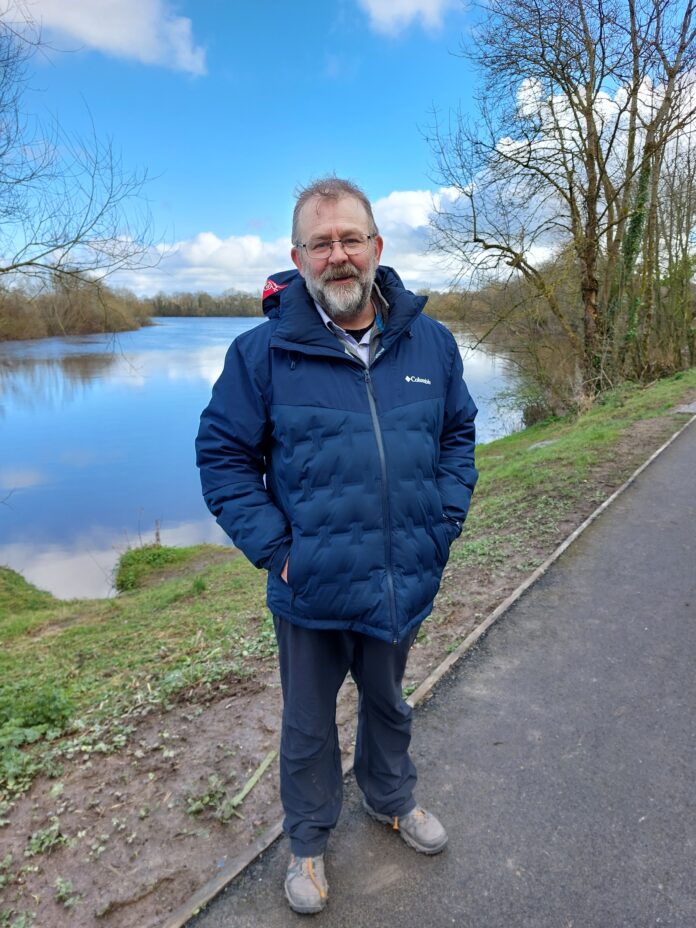
THE Atlantic Salmon is synonymous with the River Shannon but Green Party councillor Seán Hartigan now fears that the proposed Water Supply Project could be the final nail in the critically endangered species’ coffin towards extinction.
Uisce Éireann are currently in the final stages of preparing a planning application for abstraction of water from the lower River Shannon at Parteen Basin in County Tipperary, downstream of Lough Derg and just upstream of Limerick.
The proposal includes treatment of the abstracted water at Birdhill, County Tipperary and piping the treated water 170km through Tipperary, Offaly and Kildare to a termination point reservoir at Peamount in County Dublin. The treated water is to connect into the Greater Dublin Area water supply network, with capacity to provide water to communities along the route.
The state-owned water utility company (formerly Irish Water), explains that the project’s purpose is to deliver transformative water services that enable communities to thrive. For the Eastern and Midlands Region, they say, rising to this challenge requires a new water source.
“Today, we have just one source to supply 85 per cent of the water for the Greater Dublin Area – the River Liffey. This dependence on the Liffey (and the two main treatment plants of Ballymore Eustace and Leixlip) results in a serious vulnerability to risks such as prolonged drought and/or contamination.
“Furthermore, economic growth, population growth including the demand for housing and the impact of climate change means our forecasts show that the region will need 34 per cent more water by 2044 than is available today. This combination of a growing water supply deficit and lack of supply resilience is not sustainable-we need a new source of water.
“The solution is the Water Supply Project Eastern and Midlands Region. A critical national infrastructure project, it will have capacity to support water supply needs for up to 50 per cent of our population. It will bring treated water from the Parteen Basin to Peamount in Dublin with the capacity for offtakes along the route in Tipperary, Offaly and Westmeath. It will also enable supplies serving Dublin to be redirected back locally in Carlow, Wicklow, Meath and Louth,” Uisce Éireann explains.
Cllr Hartigan told the Limerick Post when we caught up with him on the Plassey bank this week that his concerns about this project broadly converge around two points.
“The transfer of water resources eastwards is counter to the principles of regional development and may reduce emphasis on water conservation and sufficiency and secondly that due consideration has not been given to the environmental impact, particularly on the lower River Shannon,” Cllr Hartigan insists.
He continued: “Without proper planning this project will facilitate further unfettered growth in the greater Dublin area at the expense of the regions. How long will this new supply provide climate resilience if growth in the east continues apace?
“How do we know that in 20 years if Dublin feel the pinch of further water resource scarcity due to expansion they will not again look westwards to satiate that need? The current plan only considers the water supply needs up to 2050.”
The City East representative believes that given the significant investment and the ageing infrastructure at Ardnacrusha and Parteen Weir, a longer-term plan should be developed to ensure sustainability for the next 100 years. He also takes the view that it would be far more sustainable to decrease water usage per capita rather than to supply more water.
“The drastic solution offered by the pipeline should not be a catalyst for neglect of water conservation efforts. Uisce Éireann needs to develop a long-term plan by expanding the planning horizon to 100 years to ensure the sustainability of the water supply infrastructure and address the long-term needs of the population. We need Uisce Éireann to specify the maximum capacity of the pipe to be installed and the justification for this capacity and to establish the agreed abstraction amount on a statutory footing to prevent increases as demand rises in Dublin.”
The River Shannon in Limerick was world renowned for its Salmon Fishery until the completion of Ardnacrusha power station just upstream of Limerick in 1929. The building of Ardnacrusha was a huge undertaking for a new state and it had the capacity to supply all of the countries power and replace the 300 small scale power plants that existed in cities and towns throughout the country.
However, Cllr Hartigan suggests that not much thought was given to how this development would affect the fish and ecology of the river. It was generally assumed, he says, that there would be little impact and fish would continue to migrate up and down the river as a fish pass had been installed at Parteen Weir.
“In the spring of 1930 instead of following the flow of the original river returning salmon were observed travelling up the “tailrace” canal leading to the new power station where they literally met a brick wall stopping their progress up river to their spawning sites. No provision had been made for fish passage at the power station, a very unsatisfactory one was installed until 1959.
There were some attempts made to divert fish from entering the tailrace using an electric fence but this killed fish which made contact with it. It took many more decades to realize the impact the barriers to fish migration had on other fish species such as eels, sea lamprey and river lamprey,” Cllr Hartigan tells me.
Up until the 1920s, there were “huge” numbers of salmon in the Shannon but the completion of Ardnacrusha Power Station in 1929 had “an immediate effect on fish migration”, according to a 2021 Department of Local Government report. Over the last few decades many people have campaigned for the restoration of proper fish passage on the Shannon to restore populations of critically endanger, vulnerable and near threatened species such as Eels, Atlantic Salmon and Lamprey. While some measures have been put in place such as trapping fish and transporting them past the power station and protocols to reduce mortalities at the turbines these measures, Cllr Hartigan feels these are insufficient to improve populations.
“While the ESB and Uisce Éireann are presenting the Fish Passage Project and the Water Abstraction Projects to us as separate projects, both will be competing for the Shannon’s water supply with each other and with Ardnacrusha Power Station. The Water Abstraction Project has to give due consideration to the Fish Passage Project.
“The Atlantic Salmon is synonymous with the Shannon. It’s a critically endangered species that is in fear of extinction and this is another nail in the coffin. There are other fish species that are impacted as well such as River Lamprey and Sea Lamprey. It also has a huge knock on effect to birds and every other species. This issue couldn’t be more important. We’re all going to be gone in 50 years time or whatever, but hopefully the river will still be here.”
The ESB told the Limerick Post that its Sustainable Rivers Strategy includes ESB’s intention in stepping forward on their social and environmental responsibility within the rivers that they have hydro operations. This includes finding the right balance between fisheries conservation and renewable generation based on scientific evidence.
Under its Sustainable Rivers Strategy, ESB is looking at current technologies that may improve biodiversity and fish life in rivers under our management and control.
”A technical feasibility assessment will be required for any proposed solutions, and each assessment will be tailored to each individual catchment,” a spokesperson explained.
According to Uisce Éireann, measures have been taken to assess any potential environmental impacts of the Water Supply Project Eastern & Midlands Region.
“As part of the Strategic Infrastructure Development (SID) planning application, which is due to be lodged to An Bord Pleanàla at the end of 2025, an Environmental Impact Assessment Report (EIAR), Natura Impact Statement (NIS) and Water Framework Directive (WFD) compliance assessment report will be submitted by Uisce Éireann. The EIAR will report the findings of the environmental assessment undertaken by Uisce Éireann for the Proposed Project, including reporting the likely significant effects and setting out the mitigation measures to avoid or reduce likely adverse significant effects,” the national water utility revealed.
Cllr Seán Hartigan is now hosting a public meeting on this important issue at the Kilmurry Lodge Hotel in Castletroy on Thursday June 19 at 7.30pm. Anyone wishing to attend should contact Seán through his Facebook page or by email at [email protected].









